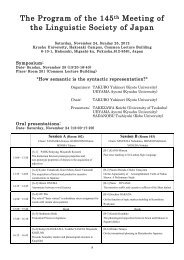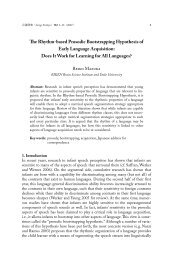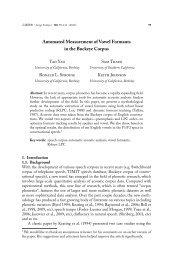第117åæ¥æ¬è§£åå¦ä¼ç·ä¼ã»å ¨å½å¦è¡éä¼ è¬æ¼ããã°ã©ã ã»æé²é PDF ...
第117åæ¥æ¬è§£åå¦ä¼ç·ä¼ã»å ¨å½å¦è¡éä¼ è¬æ¼ããã°ã©ã ã»æé²é PDF ...
第117åæ¥æ¬è§£åå¦ä¼ç·ä¼ã»å ¨å½å¦è¡éä¼ è¬æ¼ããã°ã©ã ã»æé²é PDF ...
You also want an ePaper? Increase the reach of your titles
YUMPU automatically turns print PDFs into web optimized ePapers that Google loves.
92<br />
117 <br />
S<br />
Implications of histone modification and DNA<br />
methylation during mouse spermatogenesis<br />
Ning Song, Takehiko Koji<br />
Department of Histology and Cell Biology, Nagasaki University<br />
Graduate School of Biomedical Sciences<br />
Epigenetic factors such as histone modification and DNA methylation<br />
have been implicated in the regulation of gene expression. However,<br />
the association of those factors with a specific stage of germ cells<br />
during spermatogenesis has not been fully understood. In the present<br />
study, we analysed DNA methylation states quantitatively in each<br />
germ cell by a novel method, HELMET. Histone H3 modifications<br />
were examined by immunohistochemistry. The methylation ratio<br />
of CCGG sequence gradually increased to a maximum in the<br />
stage from pachytene spermatocytes to round spermatids, and then<br />
declined. The increase in DNA methylation seemed to be correlated<br />
with deacetylation of histone H3, indicating genes are generally<br />
inactivated transcriptionally. We also found the promotion of histone<br />
H3 acetylation in parallel with DNA demethylation in elongating<br />
spermatids, may facilitate histone-protamine exchange. Interestingly,<br />
in vivo treatment of mice with 5-azadC reduced DNA methylation,<br />
but also induced H3K4me3 in spermatogonia accompanying with<br />
frequent apoptosis. These results indicate coordinate changes in the<br />
modifications of DNA and histone, and their close association with<br />
spermatogenesis.<br />
S<br />
Unique integration of fertilizationrelated protein<br />
Equatorin EQT into the acrosomal membrane<br />
during spermatogenesis<br />
Chizuru Ito, Kenji Yamatoya, Kiyotaka Toshimori<br />
Dept. Anatomy and Developmental Biology, Grad. Sch. Med., Univ.<br />
Chiba<br />
EQT is a widely distributed fertilization-related acrosomal protein in<br />
mammalian sperm. During the acrosome reaction some quantity of<br />
EQT is translocated on the plasma membrane covering the equatorial<br />
segment (ES) where sperm fuses with an oolemma, while the<br />
majority remains on the inner acrosomal membrane (IAM) until male<br />
pronucleus is formed. To analyze the nature of the EQT it is important<br />
to investigate its origin and expression during spermatogenesis. In<br />
this study we show the integration process of EQT in wild and EQT-<br />
EGFP transgenic mice using immunoelectron microscopy and highresolution<br />
light microscopy including STED nanoscopy. EQT mRNA<br />
was first detected in stage I-VII pachytene spermatocytes and then<br />
in step1-7 round spermatids. EQT protein was initially detected on<br />
the nascent outer acrosomal membrane of step 2 round spermatids<br />
and then gradually accumulated mainly on the IAM of the ES in<br />
elongating spermatids. EQT was not found acrosomal granules. We<br />
also found EQT forms complex with acrosomal matrices and the<br />
perinuclear theca (PT) by MS/MS analysis after immunoprecipitation.<br />
This evidence suggests EQT co-translocates associating with<br />
acrosomal matrices and PT.<br />
S<br />
<br />
<br />
<br />
<br />
<br />
<br />
<br />
<br />
<br />
<br />
3 4 <br />
<br />
<br />
<br />
<br />
<br />
5 3 <br />
Hoxa11/d11/d12<br />
<br />
Hox <br />
<br />
<br />
<br />
<br />
<br />
<br />
<br />
S<br />
<br />
<br />
<br />
<br />
1996







